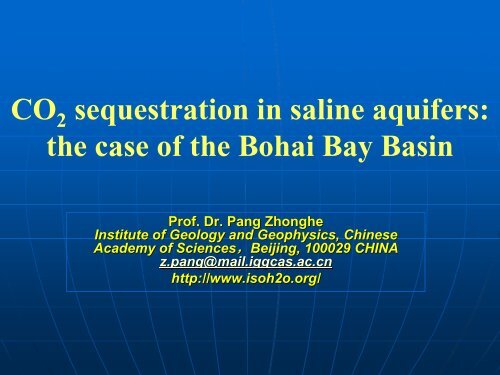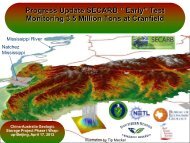the case of the Bohai Bay Basin - CAGS
the case of the Bohai Bay Basin - CAGS
the case of the Bohai Bay Basin - CAGS
Create successful ePaper yourself
Turn your PDF publications into a flip-book with our unique Google optimized e-Paper software.
CO 2 sequestration in saline aquifers:<br />
<strong>the</strong> <strong>case</strong> <strong>of</strong> <strong>the</strong> <strong>Bohai</strong> <strong>Bay</strong> <strong>Basin</strong><br />
Pr<strong>of</strong>. Dr. Pang Zhonghe<br />
Institute <strong>of</strong> Geology and Geophysics, Chinese<br />
Academy <strong>of</strong> Sciences,Beijing, Beijing, 100029 CHINA<br />
z.pang@mail.iggcas.ac.cn<br />
http://www.isoh2o.org/
Outline<br />
What’s s CO 2 Geological Sequestration ?<br />
Overview <strong>of</strong> CO 2 sequestration in China<br />
Case study—an example from <strong>the</strong><br />
<strong>Bohai</strong> <strong>Bay</strong> <strong>Basin</strong> (BBB), China<br />
Future work: saline aquifer science
What’s CO 2 Geological Sequestration ?
Overview <strong>of</strong> CO 2 saline aquifer<br />
sequestration in China<br />
• Scientific research and field test on CO 2<br />
geological sequestration<br />
• CO 2 Geological Sequestration Atlas<br />
• Projects <strong>of</strong> CO 2 sequestration in deep saline<br />
aquifers<br />
• CO 2 Capture, Utilization and Sequestration<br />
(CCUS)
Scientific research on CO 2 geological<br />
C-14 sampling at a test well<br />
sequestration<br />
Water-rock interaction lab simulation
CO 2 solution: properties and transport at microscale<br />
and super-critical conditions<br />
Magneto-suspension balance
Cap-rock mechanics<br />
Bursting pressure
Natural analogue study ---CO 2 gas field<br />
Characteristics and geological significance sandstone with dawsonite
CO 2 sequestration numerical simulation<br />
Spatial<br />
distribution <strong>of</strong><br />
CO 2 mineral<br />
trapping per<br />
m3 media ,<br />
from W.<br />
Zhang et al.,<br />
2009
25<br />
20<br />
15<br />
10<br />
5<br />
mmol/l<br />
initial solution<br />
nCO2=27.82mmol<br />
0<br />
Ca+2 K+ Na+ Mg+2 F- Cl- SO4-2 HCO3-<br />
Changes <strong>of</strong> chemical constitutes <strong>of</strong> formation before and after CO 2<br />
injection, Y.<br />
Li et al., 2010
CO 2 Geological Sequestration Atlas<br />
The National CO2 Storage Capacity and Suitability Assessment<br />
Project which is in charged by <strong>the</strong> Institute <strong>of</strong> Hydrogeology and<br />
Engineering Geology Techniques, Chinese Geological Survey is<br />
implemented since 2010.<br />
‣National CO2 storage capacity and suitability assessment<br />
and mapping (1:5,000,000)<br />
‣Candidate sedimentary basins for CO2 sequestration<br />
assessment and mapping (1:1,000,000);<br />
‣Demonstration project <strong>of</strong> CO2 sequestration in deep saline<br />
formation in Ordos basin
Geological map <strong>of</strong> sedimentary basins for CO2 sequestration<br />
in China (1:5,000,000)<br />
(IHEGT, CGS)
Sources: IHEG, CGS<br />
Crust stability <strong>of</strong> sedimentary basins for CO2 sequestration<br />
in China 91:5,000,000)
CO 2 sequestration in deep saline aquifers<br />
BBB<br />
Songliao basin<br />
(EOR)<br />
Ordos basin<br />
(Shenhua)
CO 2 Capture, Utilization and Sequestration<br />
(CCUS) progresses<br />
CO2-EOR ( e.g. Songliao basin)<br />
CO2-ECBMR (e.g. Qinshui basin)<br />
CO2 capture progresses in Clean Coal Technology<br />
(HuaNeng) and Transformation from coal to oil<br />
technology (ShenHua )<br />
CO2-EATER
CO2-EOR<br />
• CO2-EOR: CO2- Enhanced Oil Recovery<br />
• It has been carried out field testing in Jiangsu,<br />
Zhongyuan, Daqing, Shengli and Jilin oilfield and<br />
corresponding results such as injection technology,<br />
gas/water ratio, CO2 solubility in oil have obtained .<br />
Conceptual model
CO2-ECBMR<br />
CO2-ECBMR:CO2- Enhanced CoalBed Methane<br />
Conceptual<br />
Recovery<br />
model<br />
Results from Qinshui <strong>Basin</strong> indicate that single well CH4<br />
production output is 2.8-15times <strong>of</strong> that <strong>of</strong> before CO2 injection<br />
and total 192.8t liquid CO2 has been injected in <strong>the</strong> test and<br />
during reproduction period, about 30-40t CO2 go out <strong>of</strong> testing<br />
well (Ye et al., 2007).
CO 2 capture progresses (HuaNeng)<br />
Greengen<br />
group Ltd.:<br />
IGCC Power<br />
Plant 2011-<br />
2016, 250MW
IGCC conceptual model<br />
CO 2 storage system<br />
CO 2 capture demonstration project<br />
Clean Coal Technology , from National Science Exhibition <strong>of</strong><br />
The Eleventh Five Year Plan
组 分<br />
mol%<br />
CO2 88.8336<br />
CO 0.0401<br />
H2 0.1853<br />
N2 10.9227<br />
H2O 0.0000<br />
H2S 0.0003<br />
METHA‐01<br />
0.0156<br />
CH4 0.0012<br />
Ar 0.0012<br />
CO 2 Capture technology ( ShenHua )<br />
除 油 器 脱 硫 器 脱 硫 器 净 化 器 电 加 热 器<br />
CO 2<br />
压 缩 机<br />
CO 2<br />
原 料 气<br />
气 液 分 离 器<br />
精 过 滤 器<br />
CO 2 贮 罐<br />
CO 2<br />
液 化 器<br />
CO 2<br />
换 热 器<br />
组 分<br />
mol%<br />
CO2 99.9954<br />
CO 0.0000<br />
装 车 泵<br />
CO 2<br />
深 冷 器<br />
CO 2<br />
精 馏 塔<br />
H2 0.0000<br />
N2 0.0028<br />
H2O 0.0000<br />
H2S 0.0000<br />
20<br />
METHA‐01<br />
0.0011<br />
CH4 0.0005<br />
Ar 0.0001
CO2-EATER<br />
Geo<strong>the</strong>rmal exploitation<br />
• CO2-EATER: Conceptual CO2 Enhanced Aquifer Thermal<br />
CO2 injection model<br />
Energy recovery.<br />
• It means to deal with low reinjectivity <strong>of</strong> sandstone<br />
reservoir for geo<strong>the</strong>rmal water exploration in<br />
sedimentary basins in China.<br />
Aqueous CO2<br />
• It has been verified <strong>the</strong>oretically by experiments and<br />
simulation<br />
Field verification for Tianjin<br />
for CO2-EATER Guantao formation.<br />
is ongoing.<br />
CO2-EATER
Case study – Guantao saline aquifer in<br />
<strong>the</strong> <strong>Bohai</strong> <strong>Bay</strong> <strong>Basin</strong> (BBB), China
Location <strong>of</strong> <strong>the</strong> BBB<br />
Latitute:35°~42<br />
°20′<br />
Longitude: 114°30′~<br />
124°<br />
Area: 200,000km 2 , and<br />
40% are <strong>of</strong>fshore
Geological cross section <strong>of</strong> <strong>the</strong> BBB
CO 2 storage capacity assessment <strong>of</strong> deep<br />
saline formations in <strong>the</strong> BBB<br />
The suitable reservoir formations <strong>of</strong> each<br />
depression<br />
Name <strong>of</strong><br />
Depression<br />
Target evaluation<br />
formation<br />
Remarks<br />
Liaodongwan Ng,Ed (<strong>the</strong> upper<br />
& Bozhong<br />
parts) Evaluation depth<br />
ranging from<br />
Jizhong<br />
Ng, Ed<br />
800m to<br />
Liaohe Ng,Es 2<br />
,Es 4<br />
Huanghua Ng,Es 1<br />
,Es 2<br />
3500m<br />
Jiyang&Changwei Ng,Ed 1<br />
,Es 2<br />
,Es 3<br />
subsurface<br />
Linqing Ng,Es 4
Guantao formation (Ng) is a excellent reservoir for CO 2 sequestration<br />
for its physical properties and regional distribution over <strong>the</strong> basin.<br />
Normal depth<br />
range <strong>of</strong> Ng<br />
Porosity vs depth (a) and permeability vs depth <strong>of</strong> Guantao<br />
formation in Jiyang Depression
CO 2 storage capacity evaluation <strong>of</strong> <strong>the</strong> deep saline<br />
aquifers in <strong>the</strong> BBB<br />
Depression name<br />
Solubility trapping<br />
(Mt)<br />
Residual trapping<br />
(Mt)<br />
Total (Mt)<br />
Liaohe 4991.68 18.77 5010.46<br />
Liaodongwan&<br />
Bozhong<br />
42937.27 200.33 43137.60<br />
Jizhong 19019.40 649.31 19668.71<br />
Huanghua 24354.06 749.18 25103.25<br />
Jiyang&Changwei 23152.05 82.21 23234.25<br />
Linqing 33505.63 82.21 33587.84<br />
total 147960.10 1782.01 149742.11
Suitability assessment <strong>of</strong> CO 2 sequestration<br />
in <strong>the</strong> BBB<br />
‣ CO2 geological storage size (or scale) assessment<br />
‣ safety assessment<br />
‣ geo<strong>the</strong>rmal conditions assessment<br />
‣ hydrogeological conditions assessment<br />
‣ resources utilization conflicts assessment (oil & gas,<br />
geo<strong>the</strong>rmal resources)<br />
‣……..
CO2 geological storage size (or scale) assessment<br />
CO2 emission D level sources CO2 distribution storage capacity in <strong>the</strong> assessment BBB <strong>of</strong> <strong>the</strong> BBB
Safety Assessment<br />
Map <strong>of</strong> historical earthquakes<br />
distributions and crust stability
Geo<strong>the</strong>rmal conditions assessment<br />
Heat flow values distribution in Geo<strong>the</strong>rmal BBB gradient distribution in <strong>the</strong> BBB
Saline water distribution in <strong>the</strong> BBB
Resources utilization conflicts<br />
Oil distribution in Coal Geo<strong>the</strong>rmal BBB distribution water in utilization <strong>the</strong> BBB distribution in <strong>the</strong> BBB
Map <strong>of</strong> preferential zone <strong>of</strong> CO 2<br />
sequestration and<br />
corresponding capacity <strong>of</strong> each depression<br />
By consideration <strong>of</strong><br />
factors, e.g. CO 2<br />
storage size, resources<br />
utilization conflicts,<br />
safety assessment,<br />
CO 2 capacity and<br />
geo<strong>the</strong>rmal &<br />
hydrogeological<br />
conditions, some<br />
much more<br />
preferential zones for<br />
CO 2 sequestration are<br />
figured out.
Characterization <strong>of</strong> Guantao test in Beitang<br />
sag, BBB<br />
Beitang<br />
sag
Location <strong>of</strong> test site in Beitang sag in <strong>the</strong> BBB and cross-section map<br />
Hydrogeological parameters <strong>of</strong> <strong>the</strong> Injection well:<br />
• Porosity: 22.75~36.05%;<br />
• Permeability: 435.12×10 -3 ~1483.18×10 -3 μm 2<br />
• Max. yield: 112.78m 3 /h<br />
• Well head temperature: 57.5℃<br />
• water type: Cl·HCO3-Na<br />
• TDS:1693.1mg/L<br />
•pH:7.71
Field observation and sampling<br />
Nm<br />
446-1225m<br />
Ng<br />
1813.78-1815.78m<br />
Drilling cores sampling and Characterization <strong>of</strong><br />
<strong>the</strong> reservoir (Ng) and caprock (Nm)
Study <strong>of</strong> stratigraphic sequence<br />
Caprock ( Q+ Nm)<br />
Sedimentary<br />
sequence and dia-<br />
genesis <strong>of</strong> <strong>the</strong><br />
reservoir rock have<br />
been studies to help<br />
evaluate porosity<br />
and permeability<br />
distribution in <strong>the</strong><br />
reservoir<br />
Testing formation (Ng Ⅲ)
Thin section analysis <strong>of</strong> <strong>the</strong> rocks<br />
Caprock<br />
Reservoir rock
Mineral composition <strong>of</strong> <strong>the</strong> rocks(XRD)<br />
[MG001.asc] MG001, YANGFENGTIAN<br />
[NM001.asc] NM001, YANGFENGTIAN<br />
4000<br />
3000<br />
Intensity(Counts)<br />
3000<br />
2000<br />
Intensity(Counts)<br />
2500<br />
2000<br />
1500<br />
1000<br />
1000<br />
500<br />
0<br />
46-1322> Clinochlore-1MIIb - Mg5Al(Si,Al)4O10(OH)8<br />
07-0025> Muscovite-1M, syn - KAl2Si3AlO10(OH)2<br />
19-0932> Microcline, intermediate - KAlSi3O8<br />
09-0466> Albite, ordered - NaAlSi3O8<br />
46-1045> Quartz, syn - SiO2<br />
20-0481> Magnesiohornblende - (Ca,Na)2.26(Mg,Fe,Al)5.15(Si,Al)8O22(OH)2<br />
10 20 30 40 50 60<br />
Theta(deg)<br />
0<br />
46-1322> Clinochlore-1MIIb - Mg5Al(Si,Al)4O10(OH)8<br />
29-1498> Montmorillonite-15A - Na0.3(Al,Mg)2Si4O10(OH)2!4H2O<br />
14-0164> Kaolinite-1A - Al2Si2O5(OH)4<br />
07-0025> Muscovite-1M, syn - KAl2Si3AlO10(OH)2<br />
19-0932> Microcline, intermediate - KAlSi3O8<br />
09-0466> Albite, ordered - NaAlSi3O8<br />
46-1045> Quartz, syn - SiO2<br />
05-0586> Calcite, syn - CaCO3<br />
10 20 30 40 50 60<br />
Theta(deg)<br />
Samples<br />
Quartz<br />
Albite<br />
Microclin<br />
e<br />
Mineral composition %<br />
Biotite Chlorite Smectite O<strong>the</strong>rs<br />
Ng-1814m 55 12 6 3 2 _ Hornblende 3<br />
Ng-1813.78m 60 13 10 3 2 +kaolinite trace _<br />
Nm-1225m 30 13 8 4 4+kaolinite 1 trace Dolomite 16<br />
Nm-888m 45 20 10 3 2+ kaolinite trace Calcite 15<br />
Nm-965m 40 19 8 3 3+ kaolinite trace Dolomite 10+Calcite<br />
13
Chemical composition <strong>of</strong> <strong>the</strong> rocks(XRF)<br />
composition SiO2 TiO2<br />
Al2O<br />
3<br />
Fe2O3 MnO MgO CaO Na2O K2O P2O5 LOI TOTAL FeO<br />
samples (%) (%) (%) (%) (%) (%) (%) (%) (%) (%) (%) (%) (%)<br />
Ng-1814m<br />
Ng-<br />
1813.78m<br />
Nm-1225m<br />
Nm-888m<br />
Nm-965m<br />
76.3<br />
4<br />
76.8<br />
2<br />
55.0<br />
8<br />
65.4<br />
3<br />
65.0<br />
3<br />
0.27 11.13 2.26 0.03 1.09 1.23 2.48 2.73 0.09 1.94 99.59 1.02<br />
0.24 10.93 2.09 0.03 1.34 1.32 2.23 2.32 0.06 2.40 99.78 0.95<br />
0.67 13.55 5.21 0.08 5.48 4.99 1.58 2.68 0.12<br />
10.5<br />
2<br />
99.96 2.42<br />
0.60 13.85 3.83 0.31 1.12 4.04 2.06 3.05 0.13 5.62 100.04 0.31<br />
0.57 13.21 4.42 0.06 2.07 4.06 2.14 3.04 0.17 5.23 100.00 0.64
Formation water sampling<br />
• On site measurements: pH, EC,TDS, Eh, DO, Fe2+,Fe3+<br />
• 2H, 18O, 3H, 13C, 14C, 87Sr/86Sr<br />
• Major ions, trace elements, SiO2
Hydrochemistry <strong>of</strong> formation waters<br />
40<br />
Cl + SO4=><br />
60<br />
80<br />
80<br />
E<br />
60<br />
Isotopic composition <strong>of</strong> formation waters from<br />
Guantao formation, <strong>Bohai</strong> <strong>Bay</strong> <strong>Basin</strong>.
CO 2 -water-rock rock interactions<br />
Batch type autoclave (Parr 4575A )<br />
Schematic diagram <strong>of</strong> <strong>the</strong> autoclave<br />
• Batch type reactor exploring into CO 2 -water-rock interactions<br />
• Max. pressure 345bar; max. temperature 500℃; bomb volume: 500ml
Preliminary results (200℃, 200bar, 15d)<br />
[Pn.ASC]<br />
[Fn.ASC]<br />
[Pe.ASC]<br />
[Fe.ASC]<br />
[Pt.ASC]<br />
[Ft.ASC]<br />
4500<br />
4500<br />
4000<br />
4000<br />
3500<br />
3500<br />
3000<br />
0<br />
3000<br />
0<br />
2500<br />
2000<br />
2500<br />
2000<br />
5 10 15 20 25 30<br />
2-Theta(°<br />
d=10.0168<br />
d=7.1437<br />
d=4.4892<br />
d=4.0369<br />
d=3.6687<br />
d=4.2609<br />
d=3.2408 d=3.1918<br />
d=2.5517<br />
d=2.4577<br />
d=2.2823<br />
d=2.1272<br />
d=3.3459<br />
[CWS-F.asc]<br />
45.0<br />
40.0<br />
[CWS-P.asc]<br />
40.0<br />
35.0<br />
30.0<br />
25.0<br />
20.0<br />
Intensity(CPS)<br />
15.0<br />
10.0<br />
d=10.0170<br />
d=7.1447<br />
d=4.4960<br />
d=4.0405<br />
d=3.7715 d=3.7279<br />
d=3.4821<br />
d=4.2590<br />
d=3.2408<br />
d=3.1907<br />
d=2.4590<br />
d=2.2817<br />
d=2.1291<br />
d=3.3459<br />
35.0<br />
30.0<br />
25.0<br />
20.0<br />
Intensity(CPS)<br />
Intensity(CPS)<br />
Intensity(CPS)<br />
1500<br />
1500<br />
1000<br />
1000<br />
500<br />
500<br />
5 10 15 20 25 30<br />
2-Theta(°<br />
5.0<br />
x10^3<br />
10 20 30 40<br />
Theta(°<br />
15.0<br />
10.0<br />
5.0<br />
x10^3<br />
10 20 30 40<br />
Theta(°<br />
Mineral<br />
composition<br />
(%)<br />
Quartz Microcline Plagioclase Smectite<br />
Illit<br />
e<br />
Kaolinite Chlorite<br />
Clay<br />
minerals<br />
Before reaction 61.6 11.2 20.5 4.8 1.3 0.4 0.3 6.7<br />
After reaction 63.3 8.8 20 6.1 1.2 0.4 0.2 7.9
(a)<br />
(b)<br />
SEM micrographs <strong>of</strong> microcline: (a) before reaction; (b) after reaction<br />
(a)<br />
(b)<br />
SEM micrographs <strong>of</strong> albite: (a) before reaction; (b) after reaction
Field monitoring work
Soil gas monitoring<br />
Soil gas sampling and measurement<br />
114 sample have been measured and <strong>the</strong> CO 2<br />
concentration in <strong>the</strong> soil gas<br />
ranges from 1.0~10.4vol% with an average value <strong>of</strong> 2.64vol%.
Microtremor technology monitoring<br />
观 测 台 阵<br />
微 动 观 测 数 据<br />
Power<br />
10 2<br />
10 1<br />
10 0<br />
10 -1<br />
10 -2<br />
10 -3<br />
0.1 1 10<br />
Frequency(Hz)<br />
计 算 : 功 率 谱 & 空 间 自 相<br />
关 函 数 i (f, r i ) (i=1,5)<br />
SPAC<br />
Microtre<br />
mor<br />
survey<br />
work flow<br />
Depth<br />
S-W ave Velocity<br />
反 演 S 波 速 度 结 构<br />
Vs1<br />
Vs2<br />
Vs3<br />
反 演<br />
Phase Velocity(km/s)<br />
3.0<br />
2.0<br />
1.0<br />
0.0 1.0 2.0 3.0<br />
Frequency(Hz)<br />
获 得 相 速 度 频 散 曲 线<br />
f<br />
c<br />
拟 合 贝 塞 尔 函 数 , 求 得 x i ;<br />
2 <br />
fr<br />
i<br />
计 算 相 速 度<br />
c<br />
i<br />
<br />
x<br />
i<br />
探 测 成 果<br />
数 据 处 理<br />
V<br />
4<br />
4<br />
ti<br />
Vr<br />
, i<br />
ti<br />
1Vr<br />
, i1<br />
1/4<br />
x, i<br />
(<br />
)<br />
ti<br />
ti<br />
1<br />
Micro-shake cross section<br />
Micro-shake depth measuring<br />
数 据 采 集
Microtremor field measurement layout<br />
Field data collection<br />
points<br />
detection instruments
Hydrogeochemistry monitoring<br />
Water chemistry (including both major and trace<br />
elements)<br />
Isotopes (including δ 18 O H2O , δ 2 H H2O , δ 18<br />
δ 13 C DIC …)<br />
18 O CO2 ,<br />
dissolved gas monitoring<br />
pH, Temperature, Pressure <strong>of</strong> monitoring wells<br />
around
Future work: saline aquifer science<br />
• Deep saline aquifers (DSA): a most promising option for CGS<br />
• Concept: field tests can be onshore, but commercial scale<br />
deployment <strong>of</strong>fshore<br />
• Geochemical response <strong>of</strong> DSA to huge amount <strong>of</strong> CO 2 injection:<br />
future focus!!<br />
• CCUS-Utilizing Utilizing CO 2 while sequestrating it<br />
• CO 2 -EOR<br />
• CO 2 -EATER (enhanced aquifer <strong>the</strong>rmal energy recovery)<br />
A new discipline to emerge:<br />
Saline aquifer science and engineering !
谢 谢 !<br />
Thanks !




![The CO2CRC Otway Project Stages 1 and 2 [PDF 5MB] - CAGS](https://img.yumpu.com/39348781/1/190x135/the-co2crc-otway-project-stages-1-and-2-pdf-5mb-cags.jpg?quality=85)


![CAGS CCS Summer School Program [PDF 224KB]](https://img.yumpu.com/39348745/1/184x260/cags-ccs-summer-school-program-pdf-224kb.jpg?quality=85)


